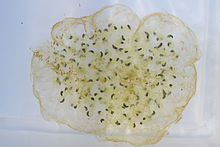Chlorococcum amblystomatis, synonym Oophila amblystomatis,[1] commonly known as chlamydomonad algae or salamander algae, is a species of single-celled green algae. When placed in the genus Oophila, it was the only species.[2] The Latin specific name amblystomatis means "loves salamander eggs". It does not occur anywhere in nature other than in the eggs of the spotted salamander, Ambystoma maculatum. The alga can invade and grow in the amphibian's egg capsule. Once inside, it metabolizes the carbon dioxide produced by the embryo and provides it with oxygen and sugar as a result of photosynthesis. This is an example of symbiosis,[3] and the only known example of an intracellular endosymbiont microbe in vertebrates.[4][5]
| Chlorococcum amblystomatis | |
|---|---|

| |
| Ambystoma maculatum clear egg mass with green color from algae | |
| Scientific classification | |
| (unranked): | Viridiplantae |
| Division: | Chlorophyta |
| Class: | Chlorophyceae |
| Order: | Chlamydomonadales |
| Family: | Chlorococcaceae |
| Genus: | Chlorococcum |
| Species: | C. amblystomatis
|
| Binomial name | |
| Chlorococcum amblystomatis (F.D.Lambert ex N.Wille) N.Correia, J.Varela & Leonel Pereira[1]
| |
| Synonyms[1] | |
| |
This symbiosis between Chlorococcum amblystomatis and the salamander may exist beyond the oocyte and early embryonic stage. Chlorophyll autofluorescence observation and ribosomal DNA analysis suggest that this algal species has invaded embryonic salamander tissues and cells during development and may even be transmitted to the next generation.[6]
Chlorococcum amblystomatis are only found in freshwater in woodland ponds. They grow best at a water depth of 30 cm (12 in) with the water temperature being 15 °C (59 °F) and an air temperature of 14 °C (57 °F). Their optimal pH tolerance ranges from 6.26 to 6.46 and they require an environment where there is 12 hours of sunlight and 12 hours of darkness. Cells are motile: they are able to move the water by the use of a flagellum. Oophila amblystomatis can reproduce sexually and asexually. 16S rRNA has been partially sequenced as well as the 18S rRNA for the plasmid, however whole genome sequencing has not been done.[7]
See also edit
References edit
- ^ a b c Guiry, M.D.; Guiry, G.M. "Chlorococcum amblystomatis". AlgaeBase. World-wide electronic publication, National University of Ireland, Galway. Retrieved 2022-02-23.
- ^ Guiry, M.D.; Guiry, G.M. "Oophila". AlgaeBase. World-wide electronic publication, National University of Ireland, Galway. Retrieved 2022-02-23.
- ^ Nature Trivia, Spotted Salamander Archived 2010-08-02 at the Wayback Machine at Henderson State University. Accessed 4 August 2008.
- ^ Frazer, J. (2018-05-18). "Algae Living inside Salamanders Aren't Happy about the Situation". Scientific American. Retrieved 2018-05-21.
- ^ Burns, J. A.; Zhang, H.; Hill, E.; Kim, E.; Kerney, R. (2017). "Transcriptome analysis illuminates the nature of the intracellular interaction in a vertebrate-algal symbiosis". eLife. 6: e22054. doi:10.7554/eLife.22054. PMC 5413350. PMID 28462779.
- ^ Kerney, Ryan; et al. (2011). "Intracellular invasion of green algae in a salamander host". PNAS. 108 (16): 6497–6502. Bibcode:2011PNAS..108.6497K. doi:10.1073/pnas.1018259108. PMC 3080989. PMID 21464324.
- ^ Lin, Yuan; C. D. Bishop (2015). "Identification of free-living Oophila amblystomatis (Chlorophyceae) from Yellow Spotted Salamander and Wood Frog breeding habitat". Phycologia. 54 (2): 183–191. doi:10.2216/14-076.1. S2CID 83838616.
Further reading edit
- Gilbert, P. W. (1942). "Observations on the eggs of Ambystoma maculatum with especial reference to the green algae found within the egg envelopes". Ecology. 23 (2): 215–227. doi:10.2307/1931088. JSTOR 1931088.
- Kim, E.; Lin, Y.; Kerney, R.; Blumenberg, L.; Bishop, C. (2014). "Phylogenetic analysis of algal symbionts associated with four North American amphibian egg masses". PLoS ONE. 9 (11): e108915. Bibcode:2014PLoSO...9j8915K. doi:10.1371/journal.pone.0108915. PMC 4230919. PMID 25393119.
- Valls, J. H.; Mills, N. E. (2007). "Intermittent hypoxia in eggs of Ambystoma maculatum: embryonic development and egg capsule conductance". J. Exp. Biol. 210 (14): 2430–2435. doi:10.1242/jeb.003541. PMID 17601946.
External links edit
- Green Eggs and Jam: Adaptations That Help Spotted Salamanders Reproduce at Henderson State University.
- Ambystoma maculatum, the spotted salamander, at AmphibiaWeb.
- Image of salamander egg with algae at North Carolina Museum of Natural Sciences.